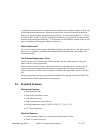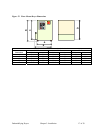Dehumidifying Dryers Chapter 2: Functional Description 12 of 59
A small amount of ambient air is introduced into the process air stream to make up for the air
lost during the bed regeneration. Because the process air is typically much drier than the
ambient air, the air mixture maintains drying efficiency at a consistently high level. This air
is heated to 500° F (260° C) before entering the bed that is on regeneration forcing moisture
from the desiccant before exhausting. To compensate for the humidity content in the air, this
dryer is supplied with the proper amount of desiccant.
What is desiccant?
Desiccant is a material that attracts and holds (absorbs) water from the air. The desiccant our
dryers use is a synthetic crystalline metal aluminosilicate blended with a clay binder and
formed into beads.
The Process/Regeneration Cycle
Our dryers have two desiccant beds. While one bed is on-line in the process air loop, the
other is off-line, being regenerated.
When a desiccant bed is on-line, it absorbs moisture from the process air. In time, the bed
becomes saturated with moisture and needs to be regenerated. The dryer automatically
redirects the process airflow to the second bed, and starts the regeneration cycle on the first
bed.
During regeneration, the dryer system heats air and forces it through the desiccant bed. The
moisture driven off the bed bleeds to the atmosphere.
2-3 Standard Features
Mechanical Features
• Dual desiccant beds
• Electrically-actuated air valve
• 13X Molecular Sieve
• Single regenerative process blower
• Drying temperature range of 180ºF to 250ºF (71° C to 121° C).
• 2.5” hose connections
Electrical Features
• Process thermocouple to be connected to drying hopper air inlet.
• Nema 12 control enclosure


















